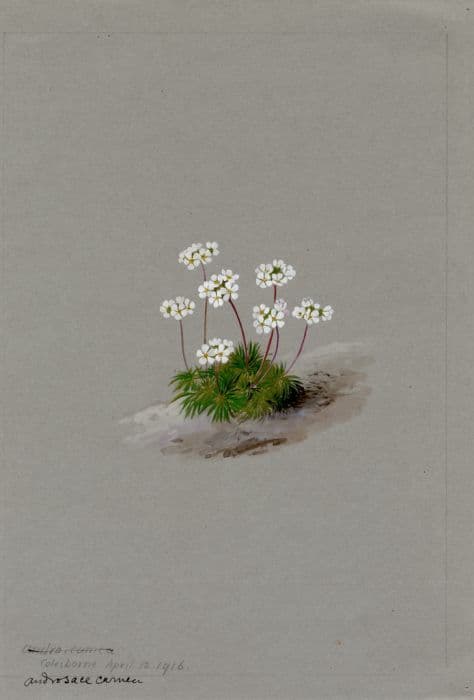Primrose Primula Danova Series (Pr/prim)

ABOUT
The Primula Danova Series, commonly known as Primrose, is a charming and vibrant flowering plant that boasts an array of colors. This series of Primrose is specifically bred for large, showy flowers that come in a wide range of hues, including red, pink, blue, yellow, and white, often with contrasting centers or a beautiful fading effect. The blossoms are typically arranged in umbel-like clusters atop short stalks which emanate from a rosette of green leaves. The leaves of the Primrose are oblong-lanceolate in shape and boast a gentle crinkly texture with a somewhat ruffled appearance. They are a deep, lush green and can provide a verdant backdrop that makes the blossoms stand out even more prominently. The velvety flowers are typically comprised of five rounded petals, occasionally notched at the tips, forming a funnel-like shape towards the center where a small, yellow eye can often be seen. This adds a striking contrast to the petals' colors and further heightens their appeal. The Primula Danova Series is a herald of spring, producing its colorful display when many other plants are still dormant. Due to their visual appeal, these flowers are popular among gardeners and are often used in beds, borders, and as cheerful additions to container gardens or window boxes. The Primrose is appreciated not just for its beauty but also for its early blooming season, lighting up gardens at a time when color can otherwise be scarce.
About this plant
 Names
NamesFamily
Primulaceae
Synonyms
Danova Primrose, English Primrose
Common names
Primula Danova Series.
 Toxicity
ToxicityTo humans
The Primula, commonly known as primrose, is considered to be mildly toxic to humans if ingested. The main toxic component is a compound called primin which can cause dermatitis in sensitive individuals. If primrose parts are ingested, they may cause mild symptoms such as nausea, vomiting, or diarrhea. It's important to keep in mind that while toxic effects are generally not severe, it is advisable to seek medical attention in the event of ingestion, especially in the case of children or individuals with heightened sensitivity.
To pets
For pets, specifically cats and dogs, the primrose or Primula can also be considered mildly toxic. If ingested, the plant can potentially cause mild gastrointestinal upset, which may include symptoms like vomiting or diarrhea. Although the toxicity of primrose is generally low, pets may also experience drooling or show signs of oral irritation. It is important to prevent pets from ingesting the plant and to consult a veterinarian if any signs of poisoning appear.
 Characteristics
CharacteristicsLife cycle
Perennials
Foliage type
Semi-deciduous
Color of leaves
Green
Flower color
Varies
Height
6-8 inches (15-20 cm)
Spread
6-8 inches (15-20 cm)
Plant type
Herb
Hardiness zones
5
Native area
Europe
Benefits
 General Benefits
General Benefits- Vibrant Colors: The Primula Danova Series (English Primrose) offers a wide array of bright and cheerful colors that can liven up any garden space.
- Early Spring Blooms: They are among the first flowers to bloom in early spring, providing color when many other plants are still dormant.
- Compact Growth: English Primroses have a compact, low-growing habit, making them ideal for borders, small gardens, and container planting.
- Shade Tolerance: These plants can thrive in partial shade, perfect for garden spots that don't receive full sunlight.
- Cool Weather Tolerant: They are hardy in cool temperatures and can withstand late spring frosts, which is beneficial for gardeners in cooler climates.
- Extended Blooming Period: With proper care, English Primroses can have a long blooming period, offering flowers for several weeks.
- Attracts Pollinators: English Primroses attract bees and butterflies, which is essential for pollination in the garden.
- Easy to Grow: They are considered to be low-maintenance, making them a good choice for novice gardeners or those who prefer less fussy plants.
- Versatile Use: Primula Danova Series can be used in a variety of garden settings, such as rock gardens, woodland plantings, and as underplanting for shrubs and tall perennials.
 Medical Properties
Medical PropertiesThis plant is not used for medical purposes.
 Air-purifying Qualities
Air-purifying QualitiesThis plant is not specifically known for air purifying qualities.
 Other Uses
Other Uses- Primulas, like the Primula Danova Series, can be used in creating natural dyes for fabrics, with different parts of the plant yielding a range of color hues.
- These plants can serve as a living mulch under taller shrubs or trees, helping to maintain soil moisture and suppress weeds.
- The flowers are edible and can be crystallized or used as a decorative, flavorful garnish on salads and desserts.
- They can be used in educational settings to teach children about plant biology and lifecycles, due to their visible and distinct flowering phases.
- Primulas can be pressed and included in botanical art or craft projects, like creating natural bookmarks or cards.
- During thematic gardens or garden competitions, Primulas provide vibrant color themes for visual storytelling and garden design.
- They can be used as indicators of seasonal change in the garden, as they are one of the first plants to bloom in spring.
- In photography, the Primula's vivid colors and patterns offer a rich subject matter for macro and close-up imagery.
- As container plants, they can bring life and color to urban spaces like balconies and patios where ground planting isn't possible.
- Their wide range of colors can also contribute to color therapy practices in horticultural therapy programs, potentially influencing mood and emotions.
Interesting Facts
 Feng Shui
Feng ShuiThe Primrose is not used in Feng Shui practice.
 Zodiac Sign Compitability
Zodiac Sign CompitabilityThe Primrose is not used in astrology practice.
 Plant Symbolism
Plant Symbolism- Youth - Primula, commonly known as Primrose, often symbolizes youth due to its early spring blooming, signifying new life and beginnings.
- Hope - The bright and varied colors of Primrose flowers are seen as a sign of hope and positivity, lifting spirits after the dark, cold winter months.
- Renewal - As one of the first flowers to bloom in spring, Primroses are associated with renewal, the cycle of life, and the rejuvenation of nature.
- Love - In Victorian floriography, Primroses can represent young or first love, possibly due to their delicate appearance and association with spring.
- Happiness - With its cheerful appearance, the Primrose is often considered a bringer of happiness and is given as a gift to convey joy.
 Water
WaterPrimroses, such as the Primula Danova Series, prefer consistently moist soil, so it's best to water them once or twice a week depending on the climate and soil drainage. During the active growth period in spring and autumn, they may need more frequent watering, especially if the weather is dry. Provide them with about one inch of water each week; in terms of gallons, this generally translates to approximately 0.623 gallons per square foot per week for outdoor plants. Ensure that water reaches the root zone by using a gentle shower from a watering can or garden hose to avoid dislodging the soil around the plants.
 Light
LightPrimroses thrive in bright, indirect light or partial shade. The ideal spot for the Primula Danova Series would be an area that receives morning sun and afternoon shade, or dappled sunlight throughout the day. Direct, strong sunlight can damage the leaves and flowers, so a location sheltered from intense midday rays is best to keep the plant healthy and vibrant.
 Temperature
TemperaturePrimroses, such as the Primula Danova Series, prefer cool to moderate temperatures with the ideal range being between 50°F and 70°F. They can tolerate a minimum temperature of 32°F, guarding against frost damage. The maximum survivable temperature is around 80°F, but prolonged exposure to heat above this can stress the plants. For gardeners, it's essential to provide some shade and cooling strategies during the peak summer months.
 Pruning
PruningRegularly deadhead spent flowers of the Primula Danova Series to encourage additional blooms and maintain plant vigor. Pruning can be done throughout the blooming season as flowers fade. You should also remove any yellow or damaged leaves to keep the plant healthy and prevent disease. The best time to do a more thorough pruning is immediately after flowering has finished in late spring or early summer.
 Cleaning
CleaningAs needed
 Soil
SoilThe best soil mix for Primroses (Primula Danova Series) should be rich, well-draining, and moist with a pH between 6.0 and 7.0. An ideal mix could be composed of peat moss, garden loam, and perlite in equal parts to ensure good aeration and water retention. Regularly check the soil moisture and avoid letting it dry out or become waterlogged.
 Repotting
RepottingPrimroses (Primula Danova Series) typically need repotting every 1-2 years to refresh the soil and accommodate root growth. It's best to repot in the late winter or after flowering to minimize stress on the plant. Use a slightly larger pot each time to allow for growth.
 Humidity & Misting
Humidity & MistingPrimroses (Primula Danova Series) prefer higher humidity levels, around 50-60%. They thrive with a consistent supply of moisture in the air but do not require the levels of tropical plants. Avoid placing them near heating vents or air conditioners that can dry out the air.
 Suitable locations
Suitable locationsIndoor
Keep Primroses in bright, indirect light, cooler temps, and high humidity.
Outdoor
Plant in partial shade, protect from the midday sun, and shelter from winds.
Hardiness zone
5-9 USDA
 Life cycle
Life cycleThe life cycle of the Primula Danova Series, commonly known as Primula or Primrose, begins with seed germination, where under appropriate conditions of moisture and temperature, the seeds sprout and the first roots and leaves emerge. The plant then enters the vegetative stage, developing a rosette of leaves that are dark green on the upper side and lighter beneath, which grow close to the ground. This is followed by the flowering stage, where the Primula Danova typically produces large, vibrant flowers in a range of colors atop sturdy stems in late winter to spring. After pollination, the plant will set seed, marking the reproductive stage, and seeds are either collected for propagation or allowed to fall naturally to the soil. As an herbaceous perennial, the Primula Danova will then go into a dormancy phase during extreme temperatures, whether it's hot summer months or the freezing winter, conserving energy to regrow in the following season. Finally, the plant can be rejuvenated through division every few years to maintain its vigor and encourage a healthy new growth cycle.
 Propogation
PropogationPropogation time
Spring to Summer
Propogation: For the Primula Danova Series, commonly referred to as English Primrose, the most popular method of propagation is by seed. Sowing should ideally take place in late winter to early spring, in a period corresponding to February to April depending on the region's climate. To propagate English Primrose by seeds, one should start indoors by distributing the seeds on top of a moist seed-starting mix in a flat or tray. The seeds require light for germination, so they should not be covered with soil but rather gently pressed into the surface. The tray should be placed in a bright area but out of direct sunlight, maintaining a consistent temperature of about 65 to 70 degrees Fahrenheit (18 to 21 degrees Celsius). Seedlings usually emerge in 14 to 21 days. Once they're large enough to handle, the young primroses can be transplanted into individual pots before eventually being moved to their final position in the garden or landscape.









